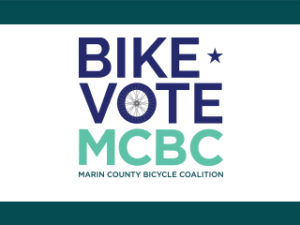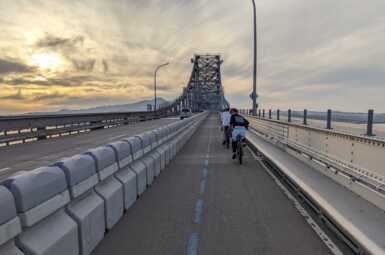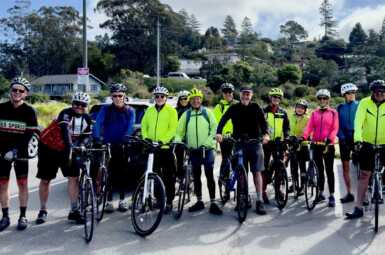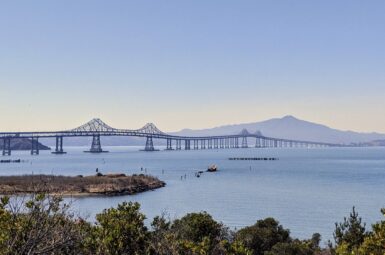June 2022 Election 2022 District 1 Supervisor Candidate Questionnaires
As a 501(c)3 nonprofit organization, Marin County Bicycle Coalition cannot endorse candidates for public office, but we are able to share information so that you can arrive at your own conclusion. Below are the 2022 District 1 Board of Supervisor candidates’ responses to our questionnaire on bicycling in Marin (click here to see a map of the district). We have made no content changes. Thanks to the candidates for their time and thoughtful answers.
Here are the candidates on the June ballot for District 1 Board of Supervisors:
-
George Saribalis
Personal Travel
1. Do you ride a bicycle? If so, for what purposes and how often? (transportation/road/mtb)
Gina Daly:
-
a. Commuting: Never
-
b. Errands: Never (I walk)
-
c. Road recreational: Never
-
d. Mountain biking or trails: Never
Mary Sackett:
-
a. Commuting: 0-3
-
b. Errands: 2+
-
c. Road recreational: Not as much as I used to
-
d. Mountain biking or trails: 1 day a week
George Saribalis:
-
a. Commuting:
-
b. Errands:
-
c. Road recreational:
-
d. Mountain biking or trails:
b and c. On weekends (2 days) a week with my kids, and once a week to ride with them to school. My wife rides with them once a week. About once a week I ride to Andy’s market for groceries.
2. If you own a bike, what type of bike(s) do you have and ride? If not, when was the last time you rode a bike, and where (on vacation, for example)?
Gina Daly:
Unfortunately, many years ago I was in a bad bike accident, but my husband and kids ride their bikes often. When we go on vacation and there are trails that are separate from vehicle traffic, I do rent a bike.
Mary Sackett:
Mostly I ride a three speed cruiser with a basket and saddle bags. I can carry my daughter’s violin, my laptop, and campaign yard signs. This is what I ride the kids to school on, ride to work on, ride to Scotty’s. It’s easy.
I also have a Specialized Sequoia road bike that doesn’t get as much use as it used to. My son and I “share” a Trek Roscoe 8 mountain bike. When my son isn’t sharing, I ride my husband’s Cannondale single speed mountain bike
George Saribalis:
An older model Santa Cruz Blur. I used to do a lot of biking in my younger days but with two young children it is hard for me to do the typing of biking I did years ago. I hope to keep my children interested in biking and increase my range. For my one annual vacation with my family, which we have taken for the last 25 years, my parents and 4 brothers take the kids and all the bikes to Twainharte and we rarely ever use a car.
Vision
3. In your own words, describe your vision for the future of transportation in District 1 and Marin County at large.
Gina Daly:
In order to meet our climate goals, we have to get people out of their cars and using bikes (or e-bikes) and public transportation to get around the County. I envision interconnecting trails and roads that allow bike and pedestrian access to transit hubs and allows people to safely go from place to place.
Mary Sackett:
I am a proponent of Seamless Transit principles. Improving wayfinding, putting riders first, making public transit equitable and accessible for all, aligning fares across service providers, connecting transit effortlessly across systems including for first and last mile connections, and ensuring that walkability and bikeability are significant factors in all future development plans.
I have worked with Safe Routes to Schools for the past eight years, not only encouraging walking and biking to schools, but leading the effort at Vallecito Elementary and Marin Waldorf School for a number of years. I have also helped with Safe Routes at Venetia Valley School, both with pathway improvements and with encouragement and outreach.
I have participated in the Safe Routes to Schools San Rafael meetings quarterly for over 5 years. I have participated in walk audits to look for safe passage at Vallecito/Mark Day, San Rafael High School, and the Meadows/Civic Center SMART to understand impediments, and to advocate for investment in infrastructure improvements. I bike and walk whenever possible, and use transit (at least I did pre-pandemic when I had meetings in Sonoma County or the City).
Any transit system must be accessible to all. Marin Transit Connect2Transit is a great compliment to our existing transit systems, providing door-to-door service for those that can’t get to a transit stop, and providing accessible vans. The bike racks on the front of the Connect2Transit vans are something I advocated for. One of many problems with transit on demand transit (Uber and Lyft) is that they don’t have an accessible fleet; Connect2Transit providers that gap coverage.
I am committed to seeing SMART succeed and be a real option for those that want to get out of their cars. I am encouraged by the new developments for completing the north-south greenway for those that can walk or bike, in particular the planning money allocated for the Civic Center to Smith Ranch segment along the SMART path.
As someone who commutes to work and errands (and campaigning) by bike, I not only believe in making public transit and walk and bike infrastructure work, I use the systems. By using these systems, I’m in a position to advocate for efficiency and effectiveness. We need to use this time of ever increasing gas prices and awareness of climate change to encourage people to try transit.
George Saribalis:
I believe there should be more accommodation of bikes and e bikes to get cars off the road. I believe there should be more use of the SMART train to keep people out of cars. I believe there should be more patrols watching children biking to school so as to give parents assurances of safety to allow more bike riding to school. In my neighborhood there has been a great increase of children biking to school versus parent drop offs by car and it has made a significant difference.
Traffic
A large proportion of peak hour traffic is made of people driving their children to school. While some people live too far to easily walk or bike to school, many parents are simply afraid to let their children travel by foot or by bicycle because of the high volume and speeds of car traffic.
4. What strategies would make more parents feel safe with their children walking or biking to school, thereby reducing traffic and making everyone else’s trip to school a little safer?
Gina Daly:
Safe Routes to School is a wonderful program, and I have supported them through my work as a Trustee for the San Rafael School Board. There have been successful programs like the walking school bus that had kids walk as a group to their local elementary school. My son’s school Vallecito encourages students to “walk or roll” to school on Wednesdays. William is getting more confident on his bike, and we hope that he will bike to school as he gets a little older. I think organizing groups of students to walk or bike together (perhaps with a parent leader) can help parents feel more comfortable.
Mary Sackett:
I believe that we need to continuously provide safe biking classes to kids and adults. As a parent I rode my kids in a trailer, which was easy. Once they started riding on their own, it became scary. Do I shout to get them to see the car backing out of the driveway? I learned the hard way that shouting made my daughter stop. Different ages and abilities of riders are a challenge, and kids don’t know the drivers’ rules of the road. We need to provide more education to students and parents who want to ride with their kids. Safe Routes does some, and I would like to double down on these training sessions! Bike Rodeo needs to be coupled with parent education, especially in the elementary schools.
I have been a member of Safe Routes to Schools for many years. I also have two school aged children that I am teaching to be responsible environmentalists, informed citizens, and good humans. Part of my plan is to continue to work with SR2S, the City of San Rafael, and at the County on walk audits around each school. Previous studies, in collaboration with feedback from parents and school staff, have led to major changes in traffic patterns, safety measures, and funding for crossing guards.
George Saribalis:
As I said above, there needs to be more patrols at the school commute times to give parents assurances, and cameras in the area to spot crime and accidents.
A survey from the Transportation Authority of Marin (Figure 18, p. 51) found that over half of Marinites would like to bike more than they currently do. This backs up research that shows that over 50% of adults are interested in biking, but concerned about the threat of fast-moving cars.
5. What concrete steps can be taken to allay these concerns and make people feel safe on bicycles?
Gina Daly:
Many people would like to bike more if they felt safer. As we rebuild our infrastructure with funding from the bipartisan infrastructure bill, we should build with bike and walk paths in mind. Most people would feel safer if there was a separation between the road and the bike path.
Mary Sackett:
I’m a huge proponent of creating safe roads for all users; safe walking and bike access to schools takes cars off the roads; dedicated bicycle lanes that connect to public transit and office centers are another tool for reducing congestion. This is best for not only bikers and walkers, but also adults pushing strollers and older adults at risk of a trip and fall.
After losing a dear friend, Paul Clark, to a bike-auto accident; and hearing about community members deaths each year, I am hesitant to allay peoples safety concerns. As Supervisor, I will continue pushing for safety improvements.
George Saribalis:
My father teaches driving. I believe there should be more emphasis on bicycle safety in the traffic schools and driver’s tests. I know my Dad emphasizes it. There need to be more dedicated lanes in areas where that is safe and will not cause traffic jams.
Safety
Traffic deaths and injuries are on the rise, both nationally and in Marin (this includes all road users, not just bicyclists). The Marin County Department of Public Works has recently adopted a Vision Zero policy setting an explicit goal to eliminate traffic deaths on County-owned roads.
However, there are often challenges in the implementation of such plans, with projects that would improve safety for all road users potentially resulting in more congestion or decreasing drivers’ top speeds (a fear expressed in the Point San Pedro Road pilot project).
6. Do you see safety as the highest priority for the transportation system? Or should it sometimes be secondary to traditional metrics like congestion and delay?
Gina Daly:
I think that we need to balance congestion with health and safety and look for opportunities where both goals can be achieved.
Mary Sackett:
Safety is the highest priority.
George Saribalis:
I believe safety comes first. Regarding congestion – idling cars create climate issues, there needs to be a balance.
Climate Change
The latest IPCC report states clearly that greenhouse gas emissions need to be reduced quickly in order to stave off the worst effects of climate change. According to Marin County’s most recent Greenhouse Gas Inventory, transportation accounts for a large share (31%) of local greenhouse gas emissions. Given that battery electric cars make up 3% of California’s vehicle fleet, and only 12% of new cars sold,
7. does reducing overall driving have a role in meeting our climate targets? If so, what policies can support transit, walking, and bicycling in place of driving for short trips?
Gina Daly:
We must increase the number of electric cars on the road and also increase use of alternate modes of transportation that do not have the impact of gas-powered cars. Public transit is at a crossroads with the pandemic. Ridership is down 60 percent in many transit agencies (according to research by the Institute of Transportation Studies at UC Berkeley). Emerging from the pandemic, we must think strategically about how to incentivize public transportation over private vehicles, which is critical to address our climate change goals.
There is a real concern that transit agencies will cut service, which will exacerbate mobility issues for people who rely on public transit. I believe we must employ a customer-centric approach to transportation. We could increase the availability and distribution of micromobility options to connect residents with major public transit centers.
We should also explore alternative funding models for public transportation because the traditional fee structure might not be sufficient given reduced demand. Some ideas are carbon market mechanisms, road user charges or property taxes to help fund public transit. We must do everything we can to preserve and strengthen public transit over the use of private cars, and we need to prioritize new housing near public transit centers.
Mary Sackett:
Yes, reducing driving has a role in meeting our climate targets, and reducing congestion.
Road building and transportation projects must include infrastructure that supports electric transportation of all types. It’s important to integrate this infrastructure in such a way that it actually gets used. For example, bike lanes and pathways that are isolated from one another tend to go unused by commuters. First and last mile connections can not be an afterthought, but must be robust. Pathways can not be an afterthought, they must be part of the planning and environmental review process for projects.
I am supportive of the Seamless Transit principles set forth in SB 917.
George Saribalis:
E bikes. That has made it easier, faster and more attractive to those who are fit and those not so fit. The County should provide opportunities for e-bike promotions and support their use.
Project Delivery
Bicycle/pedestrian plan implementation is notoriously slow with typically fewer than one new bike lane project opening every year.
8. What steps would you take to hasten the project delivery process from inception to ribbon-cutting?
Gina Daly:
We must consider bike trails and walking paths when we are redoing our infrastructure more broadly. Too often, they are forgotten, such as the proposed Freitas Parkway roundabout, which wasn’t designed to incorporate bike traffic. We should have bike and walking paths integrated into the core design elements of these projects.
Mary Sackett:
As we look at any new development, bike and ped must be included in the planning. When we replace and repair infrastructure, including roads and sidewalks, and underground pipes and conduit, we must look at opportunities for bike and ped improvements. Bike and ped needs to be considered in infrastructure replacement.
George Saribalis:
Press the State to provide more money. The surplus is over $60 billion. Active efforts by the Marin Board of Supervisors in coordination with other counties can present a powerful argument and force to get some of that money now.
In all things, there is a tension between “perfect but slow” and “fast and good enough.” Recent years have seen a move toward so-called “quick-build” infrastructure, allowing reconfiguration of streets to facilitate safer walking/biking without a years-long engineering process. While quick-build projects may be less aesthetically pleasing than the standard process, they are cheaper and happen much faster.
9. How do you rank aesthetic concerns of biking/waking infrastructure in comparison to those of cost and project speed?
Gina Daly:
I think that it is more important to improve infrastructure quickly than have a lengthy engineering and design process that will add to the cost and delay implementation.
Mary Sackett:
Safety is more important than speed. Cost is a factor in all of this. We need to have multiple projects identified, so that when funding opportunities arise, we can put the project most likely to be funded forward.
George Saribalis:
My experience has been that the faster built structures are not unattractive. Due to changes in building requirements cities are building faster and better. I do not see it as an issue.
Parking
Much of Marin has narrow streets, but on-street parking typically takes up between 30-40% of the street space between the curbs, and is often in tension with the need for dedicated bike lanes.
10. In your mind, are bike lanes ever sufficiently important to justify removing on-street parking, and in what circumstances would you consider that to be the case?
Gina Daly:
I think it makes more sense to have dedicated biking streets similar to the planning of City of Berkeley, than to remove street parking from narrow streets. These streets often already have limited parking because of fire danger. We should have a way to get through the County and City of San Rafael by bike without having to remove parking on narrow streets.
Mary Sackett:
Bike lanes justify removing on-street parking. The businesses and residents impacted by the loss of parking must be part of the process. Studies show that increasing foot traffic improves and benefits businesses.
George Saribalis:
In several towns, including Ross, there have been decisions made to only allow parking on one side of the street. I believe that can be an answer for many narrow streets for many reasons, including biking.
Wrap-up
11. Why should people who ride bikes (or those who want to ride bikes but don’t yet) vote for you?
Gina Daly:
I have two decades of experience at the local, state and federal level. Much of the funding for infrastructure projects comes from Sacramento and DC, and I know how to access the funding so Marin can accelerate investment in its infrastructure. My hope is that we will be able to have safer options for biking so that more people will feel comfortable biking.
Mary Sackett:
I am a committed bike rider who rides to work, rides with my kids, and I am committed to bicycle safety. Until we have safe streets (i.e. Vision Zero), the masses won’t bike and walk. When the masses bike and walk, we are healthier. Transportation is the largest sector of Marin’s greenhouse gas emissions, we must get out of our cars to meet our greenhouse gas reduction goals. Please take a look at my campaign video, with some fun local biking shots on the homepage of: https://www.sackettforsupervisor.com/
Thank you, I hope to earn your vote.
George Saribalis:
Because I have ridden bikes since I was 4, and still do, and I understand the thrill of it and the practicality of it. Also, I am teaching and making sure my children understand the joy of biking and get the good exercise it provides. My interests coincide with those bicycle enthusiasts in Marin, the new ones and the Marin natives that rode on Gary Fisher’s bikes, like me, when Gary was creating mountain bikes right here in Marin.
members make it happen!
We’re fighting for a more bike-friendly future in Marin. Are you with us? Join Marin County Bicycle Coalition today.
